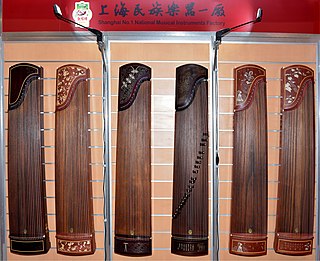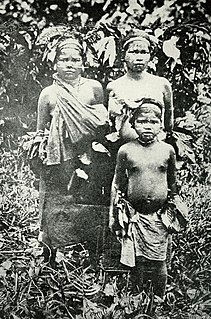Related Research Articles

The geomungo or hyeongeum is a traditional Korean stringed musical instrument of the zither family of instruments with both bridges and frets. Scholars believe that the name refers to Goguryeo and translates to "Goguryeo zither" or that it refers to the colour and translates to "black crane zither".

The zheng or guzheng, also known as a Chinese zither, is a Chinese plucked string instrument with a more than 2,500-year history. The modern guzheng commonly has 21, 25 or 26 strings, is 64 inches (1.6 m) long, and is tuned in a major pentatonic scale. It has a large, resonant soundboard made from Paulownia. Other components are often made from other woods for structural or decorative reasons. Guzheng players often wear fingerpicks made from materials such as plastic, resin, tortoiseshell, or ivory on one or both hands.

Orang Asli are the indigenous people and the oldest inhabitants of Peninsular Malaysia. Officially, there are 18 Orang Asli tribes, categorised under three main groups according to their different languages and customs:

The valiha is a tube zither from Madagascar made from a species of local bamboo; it is considered the "national instrument" of Madagascar. The term is also used to describe a number of related zithers of differing shapes and materials.
The kutiyapi, or kudyapi, is a Philippine two-stringed, fretted boat-lute. It is the only stringed instrument among the Palawano people, and one of several among other groups such as the Maranao and Manobo. It is four to six feet long with nine frets made of hardened beeswax. The instrument is carved out of solid soft wood such as that from the jackfruit tree.
The Senoi Praaq, is a unit of the Royal Malaysia Police made up almost entirely of the tribal people of Peninsular Malaysia known as the Orang Asli (aborigines). The name Senoi Praaq means war people or those who fight in the Semai language. Roy Davis Linville Jumper considered them one of the finest jungle fighting forces and was highly successful in diminishing the threat by communist forces during the Malayan Emergency.
Traditional Japanese musical instruments are musical instruments used in the traditional and folk music of Japan. They comprise a range of string, wind, and percussion instruments.
Traditional Vietnamese musical instruments are the musical instruments used in the traditional and classical musics of Vietnam. They comprise a wide range of string, wind, and percussion instruments, used by both the Viet (Kinh) majority as well as the nation's ethnic minorities.

The Senoi are a group of Malaysian peoples classified among the Orang Asli, the indigenous peoples of Peninsular Malaysia. They are the most numerous of the Orang Asli and widely distributed across the peninsula. The Senois speak various branches of Aslian languages which in turn a branch of Austroasiatic languages, many of them are also bilingual in the national language, Malaysian language. Their main means of subsistence is swidden agriculture, which may be supplemented with hunting, fishing, gathering, and the processing and sale of forest products.

The sasando, also called sasandu from Sandu or Sanu, is a tube zither, a harp-like traditional music string instrument native to Rote Island of East Nusa Tenggara, Indonesia.

Jah Hut is an Austroasiatic language spoken around the Krau river in peninsular Malaysia. The Jah Hut are one of the indigenous Orang Asli peoples.
The kulibit is a type of tube zither played by the Kalinga people of the Philippines. The instrument consists of a long tube of bamboo which has been slit to allow five or six strands of the bamboo husk to be played as "strings".
An idiochord is a musical instrument in which the "string" of the instrument is made from the same material as its resonating body. Such instruments may be found in the Indian Ocean region, disparate regions of Africa and its diaspora, and parts of Europe and North America.
The benta is a large one-string bamboo zither native to Jamaica. The instrument is an idiochord, in that the string of the instrument is made from the same piece of bamboo as composes the body. The instrument is played by two men sitting astride it at either end, one striking the string and the other changing the pitch of the string by using a gourd like a guitar slide.
Not to be confused with KREM, the CBS-affiliated television station serving the Spokane, Washington-Coeur d'Alene, Idaho area.
The takumbo is a parallel-stringed tube zither made from bamboo, and is found in the Philippines. It is made from a heavy bamboo tube about 40 cm long, with both ends closed with a node. Two strands of strings, about 5 cm apart, are partially etched out from the body of the bamboo. Small wooden bridges are inserted beneath the strings at both ends. At the center of the bamboo tube, below the strings, a small hole is bored. The small hole is covered with a bamboo plate clipped to the strings.

Jah Hut people are one of the Orang Asli tribes living in Pahang, Malaysia. As of 2000, the population of the Jah Hut people are 2,442 and by 2005, it is estimated that there are approximately 4,000 people living in 11 kampungs (villages) that are located along the west bank of the Pahang River from the north in Jerantut to the south in Temerloh, Pahang.

The kong ring or gung treng is a Cambodian tube zither, in which a tube of bamboo is used as a resonator for stings that run along the outside of the tube, lengthwise. It has the same musical purpose as the "bossed gongs" and may substitute for them and accompany singing. Although it is a traditional instrument with a long history, it has been improved on in modern times. The kong ring is represented by similar instruments in other countries of South Asia and the Pacific.
References
- 1 2 Patricia Ann Matusky; Sooi Beng Tan (2004). The Music of Malaysia . Ashgate Publishing, Ltd. pp. 298–. ISBN 978-0-7546-0831-8 . Retrieved 24 October 2012.
- ↑ Ghulam-Sarwar Yousof (2004). The Encyclopedia of Malaysia: Performing arts. Archipelago Press. p. 71. Retrieved 24 October 2012. - Called kereb or krem among the Senoi]